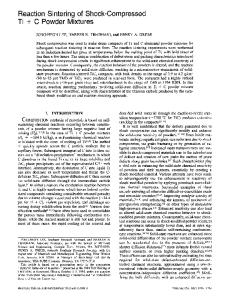Reaction sintering of alumina-aluminide alloys (3A)
- PDF / 350,881 Bytes
- 5 Pages / 612 x 792 pts (letter) Page_size
- 43 Downloads / 297 Views
MATERIALS RESEARCH
Welcome
Comments
Help
Reaction sintering of alumina-aluminide alloys (3A) N. Claussen, D. E. Garcia, and R. Janssen Advanced Ceramics Group, Technische Universit¨at Hamburg-Harburg, 21071 Hamburg, Germany (Received 8 January 1996; accepted 24 May 1996)
A novel pressureless reaction sintering process is presented for the fabrication of Al2 O3 -aluminide alloys (3A). Compacts of intensively milled metal oxide-aluminum mixtures are heat-treated in vacuum or inert atmosphere such that the exothermic reactions take place in a controlled manner essentially at temperatures below the melting point of Al. Dense, homogeneous microstructures were obtained with a variety of Al2 O3 -matrix systems with interpenetrating networks of aluminides of Ti, Fe, Nb, Mo, Zr, Ni, etc. By adding modifiers in the form of oxides or metals, volume and phase composition as well as properties can be tailored in a wide range.
I. INTRODUCTION
Metal-containing Al2 O3 composites with interpenetrating networks have recently been fabricated by various techniques, e.g., directed metal oxidation,1,2 reactive metal infiltration (C4 , RMP),3,4 and liquid metal infiltration into porous performs without5 and with gas pressure.6–8 The advantage of these composites is the fact that the Al2 O3 matrix still dominates the thermomechanical behavior, i.e., wear and oxidation resistance, high temperature strength, etc., and the metal phase improves the toughness by crack bridging, while conventional cermet-type Al2 O3 composites combine the negative properties of both constituents.9 One prerequisite for both high toughness and high strength, and possibly also wear resistance, is nearly perfect interfacial bonding10 which normally goes along with good wetting. If the metal-ceramic bond is weak, toughness may still be improved when compared to the dense ceramic; however, the strength is usually severely reduced. In both DMO and C4 reaction-formed Al2 O3 composites, sufficient interfacial bonding seems to exist between Al2 O3 and the Al alloy. The same is true for pressureinfiltrated Al–Al2 O3 composites7 when Ca is available at the interface.11 Al2 O3 gas pressure infiltrated with Ni3 Al also shows high fracture toughness (,12 MPa m1/2 ) even at temperatures ,800 ±C, although the strength is low due to weak interfacial bonding.7,8,10 This is explained by the large crystal size of Ni3 Al with respect to the Al2 O3 pore structure; thus the crack bridging intermetallic ligaments behave like single crystals during fracture. It is, therefore, expected that also other intermetallics act as reinforcements for Al2 O3 , offering composites with high ligament strength at high temperatures as well as enhanced refractoriness and oxidation resistance compared to Al2 O3 –Al alloy composites. However, densification of Al2 O3 intermetallic powder compacts by 2884
http://journals.cambridge.org
J. Mater. Res., Vol. 11, No. 11, Nov 1996
Downloaded: 02 Aug 2014
pressureless sintering has proved to be unsuccessful12 and hot pressing of such powder mixtures a
Data Loading...











